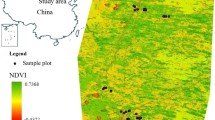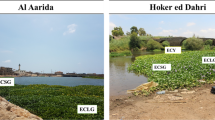Abstract
The spectral reflectance of recently formed salt marshes at the mouth of the Yangtze River, which are undergoing invasion by Spartina alterniflora, were assessed to determine the potential utility of remotely sensed data in assessing future invasion and changes in species composition. Following a review of published research on remote sensing of salt marshes, 53 locations along three transects were sampled for paired data on plant species composition and spectral reflectance using a FieldSpec™ Pro JR Field Portable Spectroradiometer. Spectral data were processed concerning reflectance, and the averaged reflectance values for each sample were reanalysed to correspond to a 12-waveband bandset of the Compact Airborne Spectral Imager. The spectral data were summarised using principal components analysis (PCA) and the relationships between the vegetation composition, and the PCA axes of spectral data were examined. The first PCA axis of the reflectance data showed a strong correlation with variability in near infrared reflectance and ‘brightness’, while the second axis was correlated with visible reflectance and ‘greenness’. Total vegetation cover, vegetation height, and mudflat cover were all significantly related to the first axis. The implications of this in terms of the ability of remote sensing to distinguish the various salt marsh species and in particular the invasive species S. alterniflora were discussed. Major differences in species with various physiognomies could be recognised but problems occurred in separating early colonising S. alterniflora from other species at that stage. Further work using multi-seasonal hyperspectral data might assist in solving these problems.
Similar content being viewed by others
References
Zhang R S, Shen Y M, Lu L S, Yan S G, Wang Y H, Li J L, Zhang Z L. Formation of Spartina alterniflora salt marshes on the coast of Jiangsu Province, China. Ecological Engineering, 2004, 23: 95–105
Xu G W, Zhou R Z. Preliminary studies of introduced Spartina alterniflora Loisel in China. Journal of Nanjing University (Advances in Spartina Research), 1985, 212–225 (in Chinese)
Gray A J, Marshall D F, Raybould A F. A century of evolution in Spartina anglica. Advances in Ecological Research, 1991, 21: 1–62
Daehler C C, Strong D R. Status, prediction and prevention of introduced cordgrass Spartina sp. invasions in Pacific estuaries, USA. Biological Conservation, 1996, 78: 51–58
Tessier M, Vivier J P, Ouin A, Gloaguen J C, Lefeuvre J C Vegetationdynamics and plant species interaction under grazed and ungrazed conditions in a western European salt marsh. Acta Oecologica 2003, 24: 103–111
Roughgarden J, Running S, Matson P. What does remote sensing do for ecology? Ecology, 1991, 72(6): 918–1922
Liu J Y, Zhuang D F, Ling Y R, Awaya Y. Vegetation integrated classification and mapping using remote sensing and GIS techniques in northeast China. Journal of Remote Sensing, 1998, 4(2): 285–291 (in Chinese)
Treitz P M, Howarth P J. Hyperspectral remote sensing for estimating biophysical parameters of forest ecosystems. Progress in Physical Geography, 1999, 23: 359–390
Yang C J, Liu J Y, Luo J C. Correlation analysis of landsat TM data and its derived data, meteorological data and topographic data with the biomass of different aged tropical forests. Acta Phytoecologica Sinica, 2004, 28: 862–867 (in Chinese)
Curran P J. The problems of remote sensing of vegetation canopies for biomass estimates. In: Fuller RM, ed. Ecological Mapping from Ground, Air and Space.Cambridge, UK: Institute of Terrestrial Ecology, 1983, 83–100
Morton A J. Moorland plant community recognition using Landsat MSS data. Remote Sensing of Environment, 1986, 20: 291–298
Trodd N M. Analysis and representation of heathland vegetation from near-ground level remote sensing. Global Ecology and Biogeography Letters, 1996, 5: 206–216
Blackburn G A, Pitman J I. Biophysical controls on the directional reflectance properties of bracken (Pteridium aquilinum) canopies: Results of field experiments. International Journal of Remote Sensing, 1999, 20: 2265–2282
Thomas V, Treitz P, Jelinski D, Miller J, Lafleur P, McCaughey J H. Image classification of a northern peatland complex using spectral and plant community data. Remote Sensing of Environment, 2002, 84: 83–99
Armitage R P, Kent M, Weaver R E. Identification of the spectral characteristics of British semi-natural upland vegetation using direct ordination: A case study from Dart moor, UK. International Journal of Remote Sensing, 2004, 25: 3369–3388
Armitage R P, Weaver R E, Kent M. Remote sensing of seminatural upland vegetation: The relationship between species composition and spectral response. In: Alexander R, Millington A, eds.Vegetation Mapping: Patch to Planet. Chichester: John Wiley and Sons, 2000, 83–102
Cochrane M A. Using vegetation reflectance variability for species level classification of hyperspectral data. International Journal of Remote Sensing, 2000, 21: 2075–2087
Artigras F J, Yang J. Hyperspectral remote sensing of habitat heterogeneity between tide-restricted and tide-open areas in the New Jersey Meadowlands. Urban Habitats, 2004, 2: 112–129
Silvestri S, Defina A, Marani M. Tidal regime, salinity and salt marsh plant zonation. Estuarine, Coastal and Shelf Sciences, 2005, 62: 119–130
Schmidt K S, Skidmore A K. Spectral discrimination of vegetation types in a coastal wetland. Remote Sensing of Environment, 2003, 85: 92–108
Thomson A G, Fuller R M, Yates M G, Brown S L, Cox R, Wadsworth R A. The use of airborne remote sensing for extensive mapping of intertidal sediments and salt marshes in eastern England. International Journal of Remote Sensing, 2003, 24: 2717–2737
Zhang M, Pinzon J, Rejmankova S L, Sanderson E W. Differentiating salt marsh species using foreground/background analysis. In: Proceedings of ERIM 2nd Annual Airborne Remote Sensing Conference, Volume 1. San Francisco, USA, 1996, 83–92
Silvestri S, Marani M, Marani A. Hyperspectral remote sensing of salt marsh vegetation, morphology and soil topography. Physics and Chemistry of the Earth, 2003, 28: 15–25
Salvitori R, Grignetti A, Casacchia R, Mandrone S. The role of spatial resolution in vegetation studies by hyperspectral airborne images. In: Proceedings of Spectral Remote Sensing of Vegetation Conference. Las Vegas, USA, 2003
Brown K. Increasing classification accuracy of coastal habitats using integrated airborne remote sensing. EARSEL eProccedings, 2004, 1: 34–42
Thomson A G, Fuller R M, Huiskes A, Cox R, Wadsworth R A, Boorman L A. Short-term vegetation succession and erosion identified by airborne remote sensing of Westerschelde salt marshes, The Netherlands. International Journal of Remote Sensing, 2004, 25: 4151–4176
Thomson A G, Fuller R M, Sparks T H, Yates M G, Eastwood J A. Ground and airborne radiometry over intertidal surfaces: Waveband selection for cover classification. International Journal of Remote Sensing, 1998a, 19: 1189–1205
Rocchini D, Chiarucci A, Loiselle S A. Testing the spectral hypothesis by using satellite multispectral images. Acta Oecologica, 2004, 26: 117–120
Malthus T J, Mumby P J. Remote sensing of the coastal zone: An overview and priorities for future research. International Journal of Remote Sensing, 2003, 24: 2805–2815
Thomson A G, Fuller R M, Eastwood J A. Supervised and unsupervised methods for classification of coasts and river corridors using airborne remote sensing. International Journal of Remote Sensing, 1998b, 19: 3423–3431
Cracknell A P. Remote sensing techniques in estuaries and coastal zones: An update. International Journal of Remote Sensing, 1999, 20: 485–496
Gray A J. Salt marsh plant ecology: Zonation and succession revisited. In: Allen J R L, Pye K, eds. Salt Marshes: Morphodynmics, Conservation and Engineering Significance. Cambridge, UK: Cambridge University Press, 1992, 63–79
Silvestri S, Marani M, Settle J, Benvenuto F, Marani A. Salt marsh vegetation radiometry: Data analysis and scaling. Remote Sensing of Environment, 2002, 80: 473–482
Zhang L Q, Yong X K. Studies on phenology and spatial distribution of Scirpus mariqueter population. Acta Phytoecologica Sinica, 1992, 16: 43–51 (in Chinese)
Huang H M, Zhang L Q, Gao Z G. A study into the vegetation resource at the intertidal zone in Shanghai using remote sensing. Acta Ecologica Sinica, 2005, 25(10): 2686–2693 (in Chinese)
Eastwood J A, Yates M G, Thomon A G, Fuller R M. The reliability of vegetation indices for monitoring saltmarsh vegetation cover. International Journal of Remote Sensing, 1997, 18: 3901–3907
Milton E J, Rollin E M, Emmery D R. Advances in field spectroscopy. In: Danson F M, Plummer S E, eds. Advances in Environmental Remote Sensing. Chichester: John Wiley and Son, 1995, 9–32
Crist E P, Cicone R J. A physical-based transformation of Thematic Mapper data-the Tasselled Cap. IEEE Transaction on Geosciences and Remote Sensing, 1984a, GE22: 256–263
Crist E P, Cicone R J. Application of the Tasselled Cap concept to simulated Thematic Mapper data. Photogrammetric Engineering and Remote Sensing, 1984b, 50: 343–352
Crist E P, Kauth R J. The Tasselled Cap de-mystified. Photogrammetric Engineering and Remote Sensing, 1986, 52: 81–86
Canas A D D, Barnett M E. The generation and interpretation of false colour composite principal component images. International Journal of Remote Sensing, 1985, 6: 867–881
McCune B, Mefford M J. PC-ORD. Multivariate Analysis of Ecological Data. Version 4. Gleneden Beach, Oregon, USA: MjM Software Design, 1999
Atkinson M D, Plummer S E. The influence of percentage cover and biomass of clover on the reflectance of mixed pasture. International Journal of Remote Sensing, 1993, 14: 1439–1444
Sims D A, Gamon J A. Relationship between leaf pigment content and spectral reflectance across a wide range of species, leaf structures and development stages. Remote Sensing of Environment, 2002, 81: 337–354
Wang Y R, Yong S P. The use of multitemporal near-ground spectral reflectance to discriminate among degraded grasslands. Acta Phytoecologica Sinica, 2004, 28: 406–413 (in Chinese)
Tucker C J, Maxwell E L. Sensor design for monitoring vegetation canopies. Photogrammetric Engineering and Remote Sensing, 1976, 42: 1399–1410
Filella I, Penuelas J. The red edge position and shape as an indicator of plant chlorophyll content, biomass and hydric status. International Journal of Remote Sensing, 1994, 15: 1459–1470
Bowers S A, Hanks R J. Reflection of radiant energy from soils. Soil Science, 1965, 2: 130–138
Hoffer R M, Johannsen J. Ecological potentials in spectral signature analysis. In: Johnson P L, eds. Remote Sensing in Ecology. Athens, Georgia, USA: Athens University of Georgia Press, 1969, 1–29
Price J C. Variability of high resolution crop reflectance spectra. International Journal of Remote Sensing, 1992, 14: 2593–2610
Price J C. How unique are spectral signatures? Remote Sensing of Environment, 1994, 49: 181–186
Davidson D A, Watson A I. Spatial variability in soil moisture as predicted from Airborne Thematic Mapper (ATM) data. Earth Surface Processes, 1995, 20: 219–230
Muller E, Décamps H. Modeling soil moisture reflectance. Remote Sensing of Environment, 2000, 76: 173–180
Bork E W, West N E, Price K P. Calibration of broad-and narrow-band spectral variables for rangeland cover component quantification. International Journal of Remote Sensing, 1999, 20: 3641–3662
Chavez A Y, Kwarteng P S. Change detection study of Kuwait City and environs using multi-temporal Landsat Thematic Mapper data. International Journal of Remote Sensing, 1998, 19: 1651–1662
Pu R L, Gong P. Hyperspectral Remote Sensing and Its Applications. Beijing: Higher Education Press, 2000, 81–86 (in Chinese)
Author information
Authors and Affiliations
Corresponding author
Rights and permissions
About this article
Cite this article
Zhang, L., Gao, Z., Armitage, R. et al. Spectral characteristics of plant communities from salt marshes: A case study from Chongming Dongtan, Yangtze estuary, China. Front. Environ. Sci. Eng. China 2, 187–197 (2008). https://doi.org/10.1007/s11783-008-0004-1
Received:
Accepted:
Published:
Issue Date:
DOI: https://doi.org/10.1007/s11783-008-0004-1




